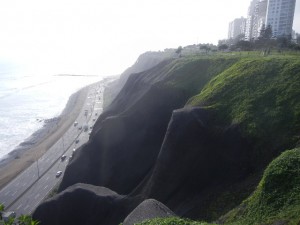29 Apr-2May: Leaving our camper in Colorado, we flew to Peru to meet our daughter Abby for three weeks. (Due to limited luggage space and a busy schedule during this side trip, Paul’s laptop stayed in Colorado, so postings beginning with this one have been delayed for up to a month.) On the way to Peru, we took a short side trip to visit Marilyn and Bob (Paul’s brother) in Coronado, California. Living on opposite coasts, we don’t get to see each other very often. While there, we had a nice telephone chat with their son Mark, who lives in Sonoma and also got to visit with their son Robb and daughter-in-law Rosa when we all went out to brunch at a great restaurant overlooking San Diego Bay. Other highlights of our visit included strolling among about 400 antique autos on display right around the corner from Bob & Marilyn’s house, a walk along the beach, looking through old family photo albums, going for a run on the bike path down the Silver Strand while 88-year-young Bob biked alongside, and spending a couple of hours at the San Diego maritime museum. Sailing vessels on display at the museum included the San Salvador, a replica of the first European vessel to reach America’s west coast when Juan Cabrillo explored the coast of California for Spain in 1542-1543; HMS Rose, a replica of the late 18th century English naval frigate featured in the movie Master and Commander; the topsail schooner California, a replica of an 1847 revenue cutter and the official tall ship of the state of California; the America, a replica of the schooner whose 1851 yacht race victory in England inspired the America’s Cup races; and the Star of India, a steel-hulled ship built in 1863 (now rigged as a bark).


Month: May 2017
Lima
3 May: Abby is in Peru for a couple of months conducting some final bits of her Ph.D. research on international water policy. She met us at the Lima airport after our overnight flight from L.A. and showed us some sights near the waterfront. We went on foot and by bus to a cafe perched on the edge of a steep bluff overlooking the bay, where we were introduced to two tropical fruit drinks, lucuma (orange-colored) and guanabana (pale green), both delicious. Then we walked along Malecon park, an attractive park and pathway for bikes and pedestrians along the top of the bluff, where Abby goes when she wants to do a long run when in Lima. At dusk we walked to the Barranca district, where there are several old colonial-period villas and we chose a seafood restaurant for supper: cheviche, chupa, and sole (all very good).


Arrival in Cusco
4 May: After our brief stay in Lima, we flew to Cusco, to focus on seeing some of the spectacular scenery and ruins in the heart of the former Incan empire. Cusco was the capital of the Incas, who dominated the Andean region for roughly 100 years until the Spanish conquest in 1532. At its greatest extent, the empire extended from present day Ecuador south to present day Chile, eastward from the Pacific coast, up across the highlands and Andes Mountains, and part way down into the Amazonian basin. “Inca” (or “Sapa Inca”) originally meant the person who ruled over the whole empire, although today “Inca” most often refers to the people of the Incan empire collectively. The Quechua-speaking people of today’s Peru are their descendants.
After settling into a charming B&B in the San Blas neighborhood, with its great view of upper Cusco and the surrounding hills, we explored the old city on foot. The streets in this part are narrow and paved with cobblestones, lined in many places by the unmistakeable and incomparable Incan stone masonry with its hand crafted polygonal stones fitted perfectly together. At the textile museum we saw some exquisite examples of traditional Peruvian woven fabrics and watched a woman demonstrating weaving on her backstrap loom. We went through displays on the history and process of chocolate making at the chocolate museum then went to a small restaurant to sample more Peruvian cuisine. We ordered from the menu of the day: a limited choice of appetizer, main course, dessert, and beverage for one fixed and inexpensive price (a commonly available option at many restaurants). Among our choices were papaya juice, quinoa soup, and alpaca.



